

The Goosander
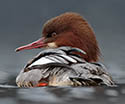 The Goosander is a medium-sized duck is a large duck and a member of a group known as the 'sawbills' after their long, narrow bills with saw-like 'teeth' which are good for gripping fish. A long, streamlined bird, the Goosander is perfectly shaped for swimming after fish. Goosanders are gregarious birds, forming flocks of thousands of birds in some parts of Europe.
The Goosander is a medium-sized duck is a large duck and a member of a group known as the 'sawbills' after their long, narrow bills with saw-like 'teeth' which are good for gripping fish. A long, streamlined bird, the Goosander is perfectly shaped for swimming after fish. Goosanders are gregarious birds, forming flocks of thousands of birds in some parts of Europe.
A white diving duck, the male Goosander has a dark green head, a black back and a long, red bill with a hook at the tip. The white sides and breast sometimes have a pink glow. The female is grey with a gingery or rufous brown head and a white throat.
Breeds on rivers in the north and west of Britain, winters on lakes and reservoirs.
Goosanders are excellent at fishing, but their diet, which includes Salmon and Trout, has brought them into conflict with fishermen making a living. The Wildlife Trusts work closely with fishermen, farmers, landowners and developers to ensure that our wildlife is both protected and provides a benefit to local people. Careful habitat management on local nature reserves is one way in which local Trusts are helping to provide areas where birds like the Goosander can thrive and avoid conflict. By volunteering for your local Trust you can help too, and you'll make new friends and learn new skills along the way.

(Mergus merganser)
The Heron
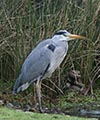 A tall, often solitary bird, the Grey Heron is one of Britain's most familiar birds. It feeds mainly on fish, but also eats small mammals (even Moles!), waterbirds (sometimes up to the size of a Coot) and Crayfish. It is often seen standing stock-still in the shallow waters of lakes, rivers and ponds, patiently hunting fish flitting about below the surface. It will visit gardens with ornamental ponds, looking for an easy meal.
A tall, often solitary bird, the Grey Heron is one of Britain's most familiar birds. It feeds mainly on fish, but also eats small mammals (even Moles!), waterbirds (sometimes up to the size of a Coot) and Crayfish. It is often seen standing stock-still in the shallow waters of lakes, rivers and ponds, patiently hunting fish flitting about below the surface. It will visit gardens with ornamental ponds, looking for an easy meal.
Easily recognised, grey-backed bird, with long legs, a long, white neck, bright yellow beak and a black eye-stripe which continues as long drooping feathers down the neck. Flies with its long legs stretched out but its neck pulled in.
Found throughout the countryside, wherever there are fish to eat.
The survival of our waterbirds is threatened by the loss and degradation of many of our wetland habitats. The Wildlife Trusts manage many wetland nature reserves for the benefit of the wildlife they support. You can help by supporting your local Trust and becoming a member; you'll find out about exciting wildlife happenings, events on your doorstep and volunteering opportunities, and be helping local wildlife along the way.

(Ardea cinerea)
The Sand Martin
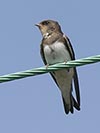 Sand martins are common summer visitors, arriving in March and leaving in October. They nest in colonies, digging burrows in steep, sandy cliffs, usually around water, so are commonly found on wetland sites. The tunnels they bore can be up to a metre in length. At a chamber at the end of the burrow, four or five eggs are laid on collected straw and feathers. Sand martins are sociable birds and will nest together in summer and gather to roost in large numbers in autumn; eventually they migrate to Africa to spend the winter.
Sand martins are common summer visitors, arriving in March and leaving in October. They nest in colonies, digging burrows in steep, sandy cliffs, usually around water, so are commonly found on wetland sites. The tunnels they bore can be up to a metre in length. At a chamber at the end of the burrow, four or five eggs are laid on collected straw and feathers. Sand martins are sociable birds and will nest together in summer and gather to roost in large numbers in autumn; eventually they migrate to Africa to spend the winter.
Our smallest swallow, the sand martin is brown above and white below with a brown breast-band and short, forked tail.
Sand Martins nest in colonies, burrowing into banks, quarries and cliffs, and usually near water. Both sexes construct the nest burrow and line the nest chamber with plant material and feathers. The eggs are white, smooth and glossy, and about 18 mm by 13 mm. Both parents take turns incubating the eggs and feeding the young.
Swallows are widespread througout the UK.
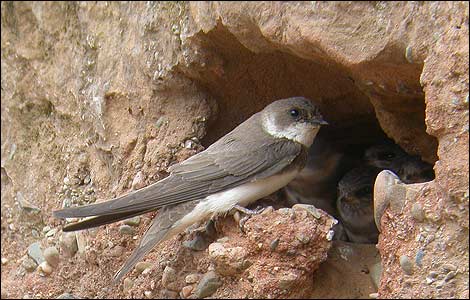
(Riparia riparia)
The KingFisher
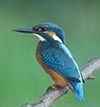 A famously colourful bird of rivers and streams, the kingfisher can be spotted sitting quietly on low-hanging branches over the water, suddenly diving in to catch a small fish. Kingfishers breed near lowland watercourses and lakes which have suitable banks for burrowing nests and shallow edges for feeding. There are over 90 species of Kingfisher which can be found all over the world. Although they are less common in the northern parts of the United Kingdom, they are more widespread in central and southern England. They have been known to visit garden ponds if they are of an appropriate size.
A famously colourful bird of rivers and streams, the kingfisher can be spotted sitting quietly on low-hanging branches over the water, suddenly diving in to catch a small fish. Kingfishers breed near lowland watercourses and lakes which have suitable banks for burrowing nests and shallow edges for feeding. There are over 90 species of Kingfisher which can be found all over the world. Although they are less common in the northern parts of the United Kingdom, they are more widespread in central and southern England. They have been known to visit garden ponds if they are of an appropriate size.
The striking mix of its bright-blue back and metallic copper breast make the kingfisher unmistakable. Male kingfishers have an entirely black bill, females have an orangey-red patch at the base.
Kingfisher live in both wetland and woodland habitats and will usually nest in tunnels in stone-free banks of slow moving streams. The tunnels, which are normally between 30-90 cm (12-36") long, are excavated by both the male and female and are usually about 0.5m from the top of the bank.
Widespread, absent from northern Scotland.

(Alcedines)
The Barn Owl
 Perhaps the most familiar owl, the barn owl will often hunt during the daytime and can be seen 'quartering' over fields and grasslands looking for its next small mammal meal. However, barn owls are also perfectly adapted to hunt in darkness with deadly precision: their silent flight and heart-shaped face which directs high-frequency sounds, help them to find mice and voles in the vegetation.
Perhaps the most familiar owl, the barn owl will often hunt during the daytime and can be seen 'quartering' over fields and grasslands looking for its next small mammal meal. However, barn owls are also perfectly adapted to hunt in darkness with deadly precision: their silent flight and heart-shaped face which directs high-frequency sounds, help them to find mice and voles in the vegetation.
Unmistakeable: the barn owl is ghostly white below, mottled silver-grey and buff above with a heart-shaped, white face and black eyes.
Although widespread across Britain and even the world, barn owls have suffered huge declines here over the last 50 years due to agricultural intensification and habitat loss. Working with farmers, landowners, other organisations and local people, The Wildlife Trusts have helped to halt this decline by providing suitable nestboxes and managing habitats for their benefit and the benefit of their small mammal prey. You can help barn owls to bounce back by volunteering for your local Wildlife Trust and helping with everything from nestbox schemes to habitat maintenance.
Widespread, absent from the Highlands of Scotland.

(Riparia riparia)
The Dipper
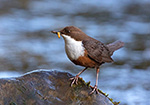 Dippers are monogamous, and the pair-bond usually lasts only for the duration of the breeding season. However, pairs can remain together from year to year, possibly as a result of attachment to a territory. A short-tailed, plump bird with a low, whirring flight. When perched on a rock it habitually bobs up and down and frequently cocks its tail. Its white throat and breast contrasts with its dark body plumage. It is remarkable in its method of walking into and under water in search of food.
Dippers are monogamous, and the pair-bond usually lasts only for the duration of the breeding season. However, pairs can remain together from year to year, possibly as a result of attachment to a territory. A short-tailed, plump bird with a low, whirring flight. When perched on a rock it habitually bobs up and down and frequently cocks its tail. Its white throat and breast contrasts with its dark body plumage. It is remarkable in its method of walking into and under water in search of food.
How to identify Dippers
Dippers feed predominantly while submerged, picking food (aquatic invertebrates including mayfly nymphs and caddisfly larvae and small fish such as minnows) from the bottom of a stream/river bed. While the majority of small food items are swallowed under the water, dippers bring larger food items to the surface to eat, and any undigested material is regurgitated as pellets.
Where to find it
Widespread on fast-flowing rivers and streams in the uplands.
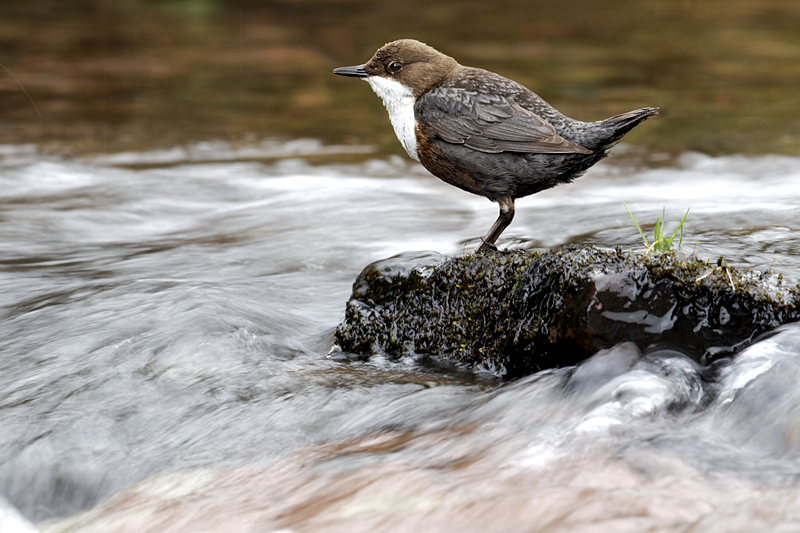
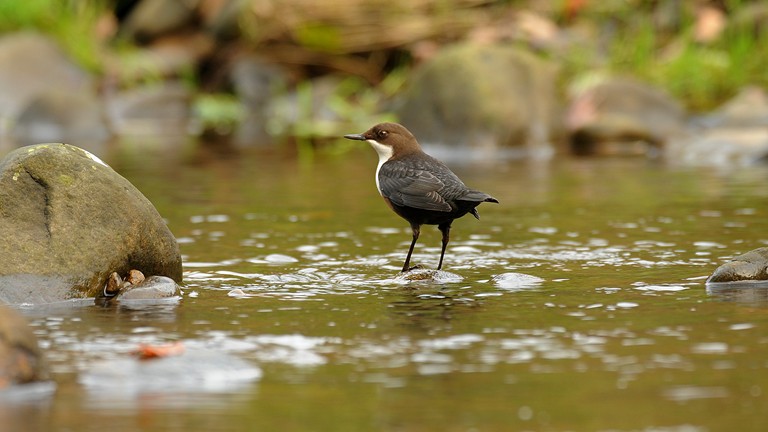
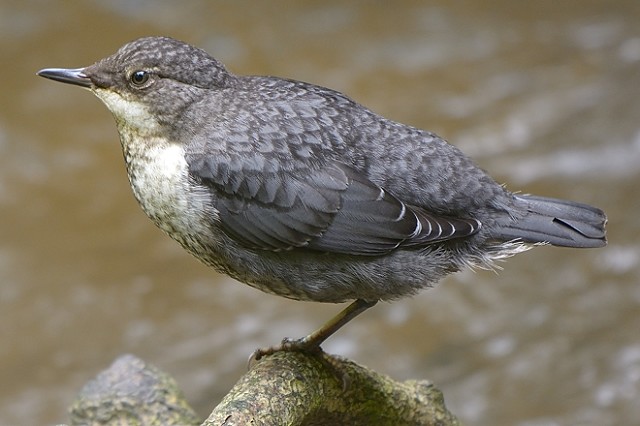
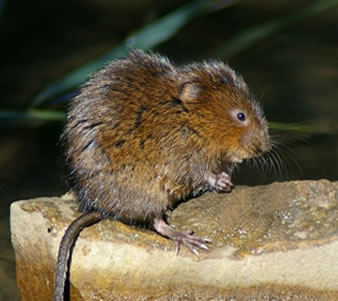
(Cinclus cinclus)
Five simple steps for you to upload to our database.
Make sure you have good reception, if you do not have good reception the image may not load into the form for you, if so try again until it loads for you.
Tip: You may want to load your image first.
Your co-ordinates will be entered automatically.
From the menu enter your species name for your sighting
Enter some notes as necessary.
If you need to take a photo or use one from your library browse for photo
Once you have photo chosen, click the submit button